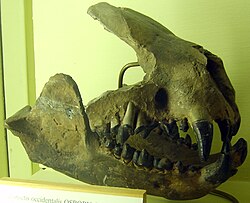| Palaeonictinae | |
|---|---|
 | |
| skull of Palaeonictis occidentalis | |
 | |
| parts of lower jaw of Ambloctonus sinosus | |
| Scientific classification | |
| Domain: | Eukaryota |
| Kingdom: | Animalia |
| Phylum: | Chordata |
| Class: | Mammalia |
| Clade: | Pan-Carnivora |
| Order: | † Oxyaenodonta |
| Family: | † Oxyaenidae |
| Subfamily: | † Palaeonictinae Denison, 1938 [1] |
| Type genus | |
| † Palaeonictis de Blainville, 1842 | |
| Genera | |
| |
| Synonyms | |
Palaeonictinae ("ancient weasels") is an extinct subfamily of placental mammals from extinct family Oxyaenidae, that lived from the late Paleocene to early Eocene of Europe and North America. [7] [8] [9]